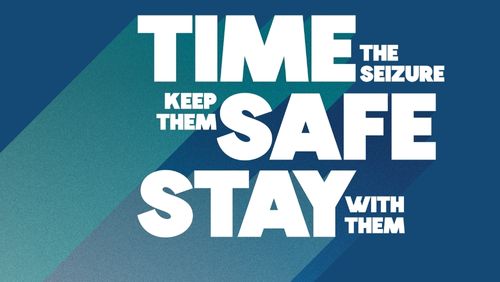
This section of our website outlines the key responses to different seizure types. However, throughout all of the below, remember the key words of Time, Safe, Stay which are explained further at the end of the page.
Generalised Onset Seizure with Motor Features (Tonic-Clonic, Tonic, Clonic, Atonic)
- Stay calm and time the seizure
- Don’t restrain the person - unless they are in danger
- Let the seizure run its course
- Put nothing in the mouth (but do wipe away saliva)
- Protect the head if necessary
- Turn the person on their side after the seizure stops
- Stay with them until they recover and respond fully
Focal Impaired/Complex Partial Seizures
- Stay calm and time the seizure
- Don’t restrain (unless the person is in real danger)
- Let the seizure run its course
- Guide the person away from danger
- Don’t agitate them
- Speak gently and reassure them
- Stay with them until they recover and respond fully
Absences, Minor Seizures, Focal Aware/Simple Partial
- Stay calm and time the seizure
- If they wander guide them gently from danger
- Wait until the person is fully recovered and responsive Reassure them and explain what happened
When should I call an ambulance?
- Call an ambulance if the seizure lasts for more than 5 minutes.
- Call an ambulance if a person having a seizure briefly comes out of it and goes into another one. This ties into point one. Both scenarios are potentially very dangerous for the person, so they need expert care.
- Call an ambulance if you know it’s a person’s first seizure or if you’re not sure whether the person has epilepsy or not (often a person with epilepsy will have a bracelet or card in their wallet/purse indicating they have epilepsy.)
- Call an ambulance if the person is physically injured e.g. if they have taken a heavy fall during their seizure.
- Call an ambulance if the person is pregnant as a precautionary measure in case any checks need to be carried out.
- Call an ambulance if you’re in any doubt – this is the most important point of all. No–one is going to be annoyed at you for calling an ambulance out of real concern; not the person who’s having the seizure and not the ambulance crew.
Watch our video...
The below video gives an overview of how to respond to both convulsive and non-convulsive seizures. Take a few moments to check it out.
As noted at the outset of this page, the key words to remember when responding to all types of seizures are Time, Safe, Stay. The below is what we communicate to the wider public in helping them better understand the response to seizures:
TIME, SAFE, STAY.
TIME
The first thing you should do is TIME the seizure. This is because if a seizure goes over 5 minutes, an ambulance should be called.
SAFE
Keep the person SAFE during the seizure. If a person is having a convulsive seizure, cushion their head with something soft if possible and remove any harmful objects, e.g. furniture from their vicinity. NEVER put anything in a person's mouth or restrain them during a seizure.
Be aware that there are also types of seizures where the person does not experience convulsions. Instead, they may “zone out” or stare blankly, become confused or agitated, display behaviours like chewing, smacking their lips, fiddling with their clothes, or wandering aimlessly. In this type of seizure, the person’s awareness of their surroundings is affected, and it is important to gently guide the person away from any danger. As with convulsive seizures, never restrict the person’s movements.
STAY
During the seizure and after it passes, STAY with the person. Often after a seizure, a person with epilepsy will be confused and in many cases, exhausted. Make sure to stay with them until recovery is complete, explain what has happened and gently reassure them. The person may have experienced an injury if they have fallen, and if this is the case, ensure normal first aid steps are taken.
At the end of this page, you can also find our seizure first aid posters that you can download and share with family, friends & colleagues so they know how to respond to a seizure. If you have any questions, please do not hesitate to contact your local Community Resource Officer. You can find their details by visiting the 'Our Services' section of our website.
- Download our poster on seizure first aid for convulsive seizures (Generalised Onset Seizure with Motor Features - Tonic-Clonic, Tonic, Clonic, Atonic)
- Download our poster on seizure first aid for non-convulsive seizure (Focal Impaired/Complex Partial Seizures, Absences, Minor Seizures, Focal Aware/Simple Partial)
